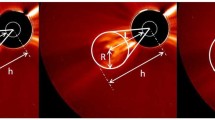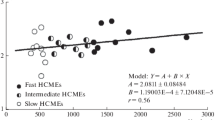Abstract
Based on the results of an analysis of AIA/SDO and EUVI/STEREO data it was confirmed that the initial phase of the “gradual” coronal mass ejection (CME) begins as a motion from the rest of the outer shell of a coronal magnetic rope, which then becomes the basis of the frontal structure of a CME. It is shown by an example of an analysis of an event on January 5, 2013 that a different type of CME, “impulsive,” can occur as a result of the ejection of a “cavity” from the lower solar corona (the 193 Å channel), which then becomes the basis for future CME. An analysis of the three-dimensional structure of the cavity, its dynamics and kinematics, as well as a comparison of the results of an analysis with numerical calculations allow us to interpret observations as a manifestation of the rapid rise of the magnetic tube (rope) filled with cold plasma. The appearance of the rope in the lower corona probably is a result of its rapid floating (with supersonic velocity) from the solar convective zone. Theoretical estimates show that the cause of the ejection of the magnetic tube from the convective zone can be the development of a Parker’s instability (“slow” wave).
Similar content being viewed by others
References
Patsourakos, S., Vourlidas, A., and Stenborg, G., Direct evidence for a fast coronal mass ejection driven by the prior formation and subsequent destabilization of a magnetic flux rope, Astrophys. J., 2013, vol. 764, p. 125. doi: 10.1099/0004-637X/764/2/125C
Eselevich, V.G., Eselevich, M.V., Romanov, V.A., et al., Physical mechanism of generation of coronal mass ejections from upper layers of the convective zone, Izv. Krymskoi Astrofiz. Obs., vol. 109, no. 3 pp. 1–7.
Eselevich, V.G. and Eselevich, M.V., Physical distinctions in the initial phase of formation of two types of coronal mass ejections, Astron. Zh., 2014, vol. 91, no. 4 pp. 320–331.
Hundhausen, A.J., Coronal mass ejections: a summary of SMM observations from 1980 and 1984–1989, in The Many Faces of Sun: Scientific Highlights of the Solar Maximum Mission, Strong, K.T., Saba, J.T. and Haisch, B.M., Eds., Preprint of High Altitude Observatory National Center for Atmospheric Research, Boulder, CO. Published by Springer, 1994.
Sheeley, N.R., Jr., Walter, H., Wang, Y.-M., et al., Continuous tracking of coronal outflows: Two kinds of coronal mass ejections, J. Geophys. Res., 1999, vol. 104 pp. 24739–24768.
Bemporad, A., Raymond, J., Poletto, G., et al., A comprehensive study of the initiation and early evolution of a coronal mass ejection from ultraviolet and white-light data, Astrophys. J., 2007, vol. 655 pp. 576–590.
Eselevich, V.G. and Eselevich, M.V., On the formation mechanism of the sporadic solar wind, Geomagn. Aeron., 2011, vol. 51, no. 8 pp. 1083–1094.
Romanov, D.V. and Romanov, V.A., Floating-up of magnetic flux from relaxation zone the photospheric level, Astron. Zh., 1993, vol. 70 pp. 134–140.
Grigor’ev, V.M, Ermakova, L.V, and Khlystova, A.I., Dynamics of radial velocities and magnetic field in the photosphere of the Sun at origination of a powerful active region, Pis’ma Astron. Zh., 2007, vol. 33 pp. 858–862.
Borrero, J.M., Martinez-Pillet, V., Schlichenmair, R., et al., Supersonic magnetic upflows in granular cells observed with Sunrise/Imax, Astrophys. J., 2010, vol. 723 pp. L144–L148.
Romanov, V.A., Romanov, D.V., and Romanov, K.V., Discharge of magnetic fields from the dynamo zone to the solar atmosphere, Astron. Zh., 1993, vol. 70 pp. 1237–1246.
Fan, Y., Magnetic fields in the solar convection zone, Living Rev. Solar Phys., 2009, vol. 6, p. 4.
Romanov, D.V. and Romanov, K.V., Numerical simulation of dynamical processes in the solar atmosphere, Vych. Tekhnologii, 2003, vol. 8, no. 6 pp. 74–95.
Fan, Y., Nonlinear growth of the three-dimensional undular instability of a horizontal magnetic layer and the formation of arching flux tubes, Astrophys. J., 2001, vol. 546, p. 509.
Lemen, J.R., Title, A.M., Akin, D.J., et al., The atmospheric imaging assembly (AIA) on the solar dynamics observatory (SDO), Solar Physics, 2012, vol. 275, p. 17.
Schwenn, R., Dal Lago, A., Huttunen, E., et al., The association of coronal mass ejections with their effects near the Earth, Ann. Geophys., 2005, vol. 23 pp. 1033–1059.
Author information
Authors and Affiliations
Corresponding author
Additional information
Original Russian Text © V.G. Eselevich, M.V. Eselevich, 2015, published in Kosmicheskie Issledovaniya, 2015, Vol. 53, No. 1, pp. 24–34.
Rights and permissions
About this article
Cite this article
Eselevich, V.G., Eselevich, M.V. Differences in the development of the initial phase of the formation of two types of coronal mass ejections. Cosmic Res 53, 21–30 (2015). https://doi.org/10.1134/S0010952515010049
Received:
Published:
Issue Date:
DOI: https://doi.org/10.1134/S0010952515010049




